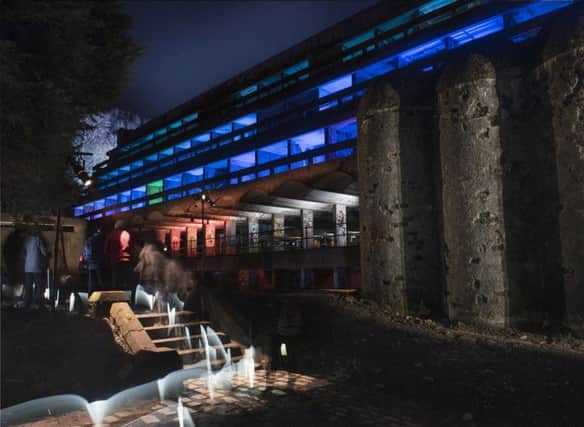Joyce McMillan: Has site-specific theatre had its day?


It’s more than 20 years, now, since the idea of site-specific theatre – or theatre made in “found space” – first burst onto Scotland’s creative scene. After the series of shows staged in great old industrial spaces that marked out Glasgow’s year as European City of Culture in 1990 – Bill Bryden’s The Ship at Harland & Wolff, Test Department’s Second Coming at St Rollox Locomotive Works – the great pioneers of the art-form were Grid Iron of Edinburgh, who chose the underground Mary King’s Close beneath the City Chambers as the venue for their acclaimed 1997 Angela Carter adaptation The Bloody Chamber. The company’s artistic director, Ben Harrison, wrote about “a perfect marriage of site and subject”, as audiences reeled from the impact of a promenade show staged in the dank subterranean spaces of an old buried vennel that was then almost unknown.
And although Grid Iron were true groundbreakers in the business of theatre staged in “real” found space – moving on to present shows in a department store, a children’s swing-park and the Edinburgh International Climbing Centre at Ratho, among many other places – within a decade the trend was sweeping across Europe and beyond, as vaults and abandoned factories and ruined hotels became scenes of new theatrical life, meditating on the past and future of a civilisation now moving at warp speed, and disposing of once-familiar spaces in the process.
Advertisement
Hide AdThose engaged in the business of “found space” tended to identify at least three impulses in this move away from conventional theatre experience. The first involved creating a form of theatre that would offer something distinctive, inimitable, not available from the dominant screen culture of our time; the smell and feel of a space we might never otherwise have visited, or truly seen. The second had to do with the fact that many of these shows are promenade productions; Ben Harrison talked about how an audience that is on its feet and moving seems much more sensually alive to the performance, and more engaged with it, than one that is just sitting in rows.
And the third involved the creative interaction between the space and the work itself; in London, I remember hearing a theatre artist talk about creating a show in what was once an old leper hospital, and about the voices that seemed to come from the very walls, as the company worked there. And since the turn of the millennium, many Scottish companies – from Sandy Thomson’s Poorboy to Cora Bissett’s Pachamama and the National Theatre of Scotland itself – have taken the route into “found space”. Bissett’s Roadkill, about the trafficking of young girls into prostitution, was famously first performed in a flat in Edinburgh; and in its first year alone, the National Theatre of Scotland produced shows in a tower-block in Glasgow, in a shop in Stornoway, and – with Grid Iron – at Edinburgh Airport.
So when the NTS announced that its current production The 306: Dawn – about British soldiers shot for desertion during the First World War – would take place in a barn in Perthshire, I assumed that the show would mark a continuation of this tradition; a creative wrestling match between a rough-edged, problematic but powerful site, and a piece of work substantially shaped by it. The inspiration lay in the fact that condemned soldiers were often held in barns on the eve of execution; but in truth, the space created by the NTS in a pristine modern barn at Dalcrue Farm in Perthshire is more like a new theatre in the countryside – all fresh wood and fine, dry flooring – than the kind of ruined and muddy spaces in which those final nights would have been spent.
There’s no doubt that the Dalcrue Farm setting is beautiful, although glimpsed only briefly on our way in and out; and the opening performance was carefully timed so that its ending coincided with a grey dawn, seen for a moment through the open barn door that admits the final firing squad. And the show, written by Oliver Emanuel, composed by Gareth Williams, and brilliantly directed by Laurie Sansom, is a magnificent piece of music theatre, that would compel audiences to pity, sorrow and anger wherever it was performed.
Yet almost every detail of it is a carefully-made part of the performance, a theatre effect that could have been created with as powerful an impact in the Tramway in Glasgow, or the SECC, or the Corn Exchange in Edinburgh; and it leaves behind an open question about whether The 306 is really a show in the “found space” tradition, or just a welcome visit by the National Theatre to Perthshire, hosted in a fine space at Dalcrue.
There are issues of money, here, of course; the NTS has resources which often empower it to build a comfortable temporary theatre wherever it goes. Yet this year, the two most substantial theatre-beyond-theatre experiences in Scotland have been The 306, and NVA’s Hinterland at St Peter’s Seminary, Cardross, created by the company that grew out of Angus Farquhar’s Test Department. At one end of the spectrum, Hinterland was an event that simply celebrated and revered its setting, lighting it, offering a little sound and movement, but essentially allowing this remarkable building to speak for itself; at the other, The 306 went to a field in Perthshire, and built itself the theatre that would show this fine work to best advantage. And I wonder if these two very different works demonstrate how the art of theatre in “found space” is evolving; or mark the end of a cycle – perhaps a moment in history – when the tension between our society and its lost or abandoned spaces was at its height, and produced some remarkable theatre work, never quite to be equalled again.
• The 306: Dawn is at Dalcrue Farm, Perth, until 11 June.